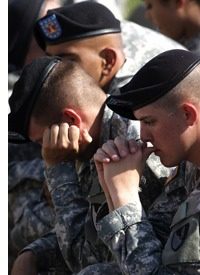
“What did you know and when did you know it?” was the infamously blunt question asked of President Richard Nixon regarding his involvement in the Watergate scandal. His unwillingness to answer that query eventually brought down his entire administration, culminating in his own historic resignation from office. Now that same question, instead of being asked of a President, is being asked by a President in regard to the Ft. Hood shooter and what if anything officials could have done to have prevented the recent tragedy.
White House Press Secretary Robert Gibbs told reporters on Tuesday that President Obama has “asked every agency involved … to investigate why this happened, how this happened, and to ensure that they can tell him that it won’t happen again.”
Judging from the investigative reports being filed in newspapers around the globe, there is plenty of blame to be shared. The Army, for example, claims to have been unaware of the dozens of messages exchanged between Major Nidal Hasan and Anwar al-Awlaki, his one-time prayer leader, an open supporter of al-Qaeda, and an unrepentant advocate of the continued use of terrorism against Americans. An unnamed Army official involved in the investigation into Hasan’s extremist proclivities and connections says that “the Army shouldn’t take the whole hit” for being blindsided by Hasan’s murderous outburst. “The system failed,” he said.
The system in this case was an unclear alliance between an FBI-run Joint Terrorism Task Force and the Pentagon-based component, the Defense Criminal Investigative Service. According to reports published Tuesday, there is evidence that a key member of this team disregarded intelligence that Hasan had been in contact with known al-Qaeda confederates. A spokesman for the FBI asserts that there was no gross negligence because the agents charged with evaluating the strength of the various signals determined that there was no legal basis for a more in-depth investigation into either Hasan’s alleged dealings with al-Qaeda associates or with his relationship with a cleric known to preach praise of the overall jihad movement declared by radical Islamists. Hasan, based on this task force’s estimation of the situation, posed no threat of violence.
For its part, the spokesman for the Defense Criminal Investigative Service, Gary Comeford, has declined comment, making speculation the only source of information as to whether the agent in question informed the Army as to the red flags being raised about one of their officers. A senior Defense Department official, speaking under the condition of anonymity, claimed, “There was no U.S. Army or other Department of Defense organization that knew of any contact he [Hasan] had with Muslim extremists.” This assertion is incredible given the frequency and volume of the warning signs that have recently been exposed and that were known to law enforcement and Defense investigators. The salient question that remains is how was so much solid information of such questionable and potentially treasonous tenor ignored for so long by so many ostensibly tasked with discovering and disarming such threats?
Very little is known, as well, about what response the Army took concerning the diatribe delivered by Major Hasan while treating veterans as a psychiatrist at Walter Reed Army Medical Center. In the speech, Hasan questioned the military presence in the Muslim world and questioned whether or not America could expect absolute loyalty from Islamic servicemen who would undoubtedly be troubled by the prospect of killing their spiritual brothers and sisters in Iraq and Afghanistan. It is still unknown how far up the chain of command the awareness of such disloyal and alarming behavior went.
While heads of various departments and agencies are likely to roll in the aftermath of the continuing investigation of the likely motivations behind the Ft. Hood massacre, the lion’s share of the blame might eventually be placed at the feet of the FBI, as it headed the network of agencies analyzing the data. Although there were several members of the team, it was the FBI that acted as quarterback and called the plays. As one Defense official said in explaining why such crucial information was apparently not shared among the various components of the security establishment, “Any and all information from the task force … has to be approved by the FBI.” Given the gravity of the situation and the dismissals that will undoubtedly result from the pressure being applied all around, such statements may just be a way to throw the star player under the bus.
In advance of any congressional hearings that will soon convene, the FBI has launched its own internal investigation as to any errors or oversights committed by its agents in the collecting, classifying, and distribution of intelligence that may have prevented the death of 13 people at Ft. Hood.
Regardless of the eventual outcome of the various reviews, inquests, and hearings that will take place over the next weeks and months, the most ironic and head-shakingingly disturbing aspect of all the inquiries is how such an irreparable failure to communicate in a timely and effective manner could plague an intra-agency intelligence apparatus that was created specifically to breakdown the bureaucratic barriers that were supposedly at the heart of the vulnerability that led to the attacks of September 11?
Photo: AP Images



